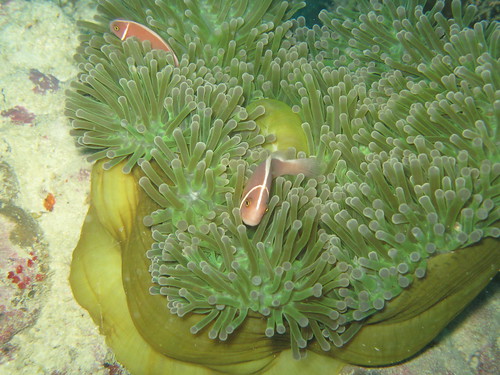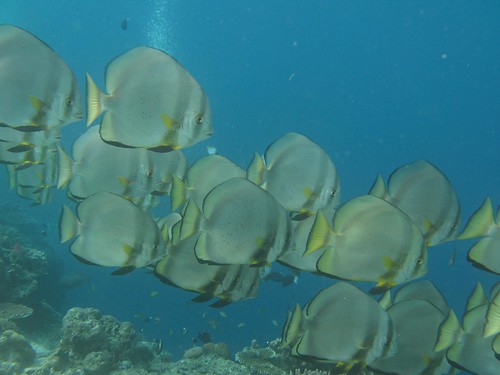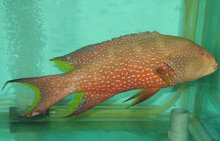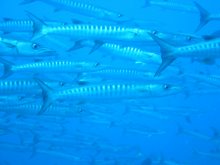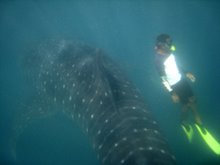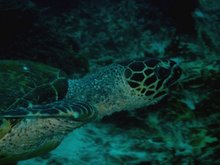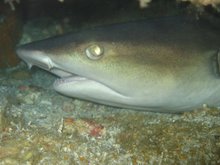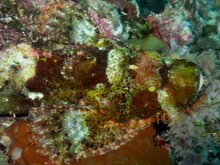Monday 30 April 2007
Closure of coral beach in Hoi Ha Wan Marine Park
"prohibiting the entry of all persons and vessels into the Area are for the protection of corals by reducing human activities and impact in the Area"
Seems a step in the right direction, however it is still possible to fish in other parts of the park with the correct permit.
Still some way to go..
Notice can be found here
Sunday 29 April 2007
Whale shark rescues in India
http://www.wildlifetrustofindia.org/html/news/2007/070416_whale_shark_rescue.html
Indian fishermen are compensated Rps25,000 for saving whalesharks caught in their nets. This appears to contrast to what is happening in other areas.
" use of the Whale Shark for food is mainly for its meat and has been documented in Taiwan, India, and the Philippines. Work carried out by TRAFFIC in co-operation with researchers at National Taiwan Ocean University in 1996-1997 identified Taiwan as a major, and possibly the largest, market for Whale Shark meat. " source: traffic.org
It should be noted that Taiwan is introducing innovative ways to ensure sustainable trade in Whaleshark meat.
Saturday 28 April 2007
Komodo National Park - mooring buoy project
The Indonesian and Philippines archipelagos are the epicentre of the worlds marine biodiversity (exact location subject to some debate, try to google 'marine biodiversity epicentre' for some intriguing differences of opinions) Komodo is certainly a magical place, great diving, huge variety of things to see underwater and fantastic scenery above sea level. To add to this is the unique terrestrial ecology of Komodo and Rinca islands.
With the recent increase in dive boats operating in the Park, an extensive mooring buoy project was initiated by Helen Newman. This project had the active involvement of the diving community in Komodo and was completed in February 2007. Coincidently this was when I was diving in the Park on the live aboard dive boat, MV Bidadari. We were the first boat to utilise a few of the new buoys.

Ouch, the potential damage to reefs is
obvious
This is the kind of project that will make a real difference and is one piece that will help to ensure the survival of this unique marine reserve. Other challenges still exist, but that is another story.....
The full final report on the mooring buoy project can be read by clicking here
Are there any other worthwhile projects out there that should be mentioned?
Friday 27 April 2007
Whale sharks
A great friend of mine, Peter Emmett, just had a wonderful trip to Donsol in the Philippines, where he snorkled with a number of sharks. Donsol does apparently have the highest density of whale sharks anywhere in the world. (source:Wikipedia) So head down there. Bringing in hard needed revenue to the local fishermen (who traditionally hunt whale sharks) is a great way to ensure its survival.
Thanks also to Peter for pointing out to me whaleshark.org, a not-for-profit organisation working to protect the threatened whale shark. One thing they are aiming to do is to have a photo library of whale shark encounters, to aid in further research. So...
If you do see a whale shark and happen to have a camera in hand, please take a photo (importantly of the pectoral fins and the pattern of spots above and around them) and send to http://www.whaleshark.org/
(more info on what they want, can be found on the above website)
Thursday 26 April 2007
Tiger Shark Feeding video clip - Scary....!!
Clip from "You Tube" showing a shark feed dive in Fiji. Hand feeding a large (3.5 - 4 metre) and very fat Tiger Shark seems absolutely crazy to me. Also check out the worlds fattest Grey Reef's and a one 'normal' non obese Silver Tip. Fish soup as well..
Tiger Shark and more - You Tube clip
Question is: "is shark feeding a good idea"
I think there are two opposing arguments regarding Shark Feed Diving
- Shark Feeds increase encounters with Sharks and can aid in their preservation, by raising awareness and reducing the mystery around sharks.
- In other parts of the world shark feeding has been blamed for the rise in attacks in South Africa. They can become habituated to humans and associate them with food.
I think controlled and well managed shark feeding probably has more plus points that negative.
But for myself, I prefer to see natural behaviour and those unexpected encounters and will vere away from shark feed dives.
Wednesday 25 April 2007
Ciguatera poisoning on the increase
Experts estimate that up to 50,000 people worldwide suffer ciguatera poisoning each year.
Hong Kong has refused to enact mandatory measures to prevent ciguatera despite increased outbreaks. It argues that educating consumers and traders is the answer, rejecting calls to crack down on traders or ban fish from suspect areas.
"Given the fact we eat so much seafood in Hong Kong, this should be one of the priorities in protecting the population," Sadovy said.
Source : wilmingtonstar.com
350 Napoleon Wrasse released back into Marine Park
Eventually the Wrasse were kept alive (with only one dying) near Puerto Princessa, Palawan and released back into the Tubbataha Reef Marine Park (a UNESCO World Heritage Site) at the end of March.
This has caused a stir in the diplomatic channels with the Chinese authorities apparently refusing to admit that this was not only an infringment of territorial waters but a clear endangered wildlife issue. The Chinese CITES authority are refusing to admit the seriousness of the chinese fishing vessels illegal activity.
Google "Hoi Wan" if you want to read more
Tuesday 24 April 2007
Email feedback to WWF on their Seafood guide
With regards to the WWF Seafood guide. On the 10th April, I wrote an email to WWF (seafood@wwf.com.hk) with some initial comments on the Seafood Guide (click here to access guide )
The contents of the email was as follows:
"
- I like the guide, I think that this is a key step in the right direction. Consumer education is absolutely key and this is a good start.
- The common names are none standard. I am not familiar with the English names used on this guide. A side guide (maybe online) with photo’s would be helpful. I notice the URL Click HERE has many but not all of the fish listed on the Seafood Guide. Could this be gradually expanded to include all the fish on your guide?
- I am concerned about the wild caught Chilean Seabass being on the Recommended list, for two major reasons:
- Chilean Seabass (also known as the Patagonian Toothfish) is fished (in many areas overfished) using long line fishing. This fishing method continues to be indiscriminate and has considerable side catch, this is resulting in a large decimation of albatross and seabird populations in the South Seas.
- How can we know that the Chilean Seabass available in Hong Kong is from the MSC certified fisheries and not from other non sustainable sources..?
- The Wikipedia entry summarises this adequately Click HERE - It is a bit difficult to know where the fish are sourced when you are eating in a restaurant. Could you add some comments how what people can do in these cases. E.g. some questions that they could ask. If the right questions are asked then maybe restaurants would also start to source from sustainable sources.
- Are there any recommended sources for Shrimps/prawns. This is extremely popular in Hong Kong and a suitable alternative is needed. At the moment this is only in the AVOID category.
- Chinese Oysters are included, however I think that Globally sourced Oysters are also very popular in Hong Kong. Is there any plans to expand the guide to include these as well as other popular seafood ?
- For non Chinese I think a phonetic representation of the Cantonese pronunciation would be very helpful.
"
As of 24th April, I have not yet received a response.
WWF - Hong Kong
Two campaigns or releases of note:
Seafood Guide: Those that know me, understand that I have been concerned for many years about the restaurant trade in Live Seafood. This guide it the first real attempt at spelling out what Seafood is okay to eat (from a conservation/sustainability point of view) and what Seafood should be avoided. Have a look, there are definitely a few surprises:
Click HERE
Save our Seas ("SOS") We have all been out on Junk Trips and boat trips in Hong Kong and have been amazed at the number and location of fishing boats trawling in Hong Kong waters. WWF's Save our Seas campaign, aims to pressure the government to setup exclusive 'no take' zones that have proved so successful in other parts of the world. Read more here:
Click HERE
About Dod
This is my first attempt at creating a BLOG, it seemed an appropriate moment to try to jot down and share with all my passion for diving and especially for Marine and Coral Reef conservation
